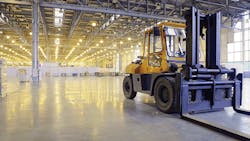One of the most important aspects when it comes to operating a forklift, and unfortunately, something that still is overlooked by some operators, is safety.
Forklift safety is a multifaceted challenge. It includes proper training, appropriate vehicle maintenance, using the right type of machine for the job as well as inspection of vehicle parts such as tires, lights and signals. Without the proper maintenance and vehicle inspection, accidents are more likely to happen.
Consider, for example, forklift tires. As with vehicles on the road, maintaining the condition of tires and the appropriate inflation rate is an important aspect of safe operation. Maintaining tires and assuring adequate inflation pays more dividends than simply good traction for any material-handling appliance. Here are other overlooked aspects of a forklift:
1) Environment – It is imperative to know what type of setting or terrain in which the forklift will be operated, especially if it has to transition from the confines of a warehouse to an outdoor setting where rough terrain is likely. This is when the functionality of your forklift as well as safety awareness comes into play.
Operating a forklift on rough terrain may require specific hardware, such as forklift tires specifically composed with higher durability to last longer and endure the elements. Certain tires are manufactured for indoor settings, while some are made for rough terrain or outdoor settings. It is key to know which of these apply to your vehicle and install the appropriate tires.
Forklift operators also should be trained in maneuvering over rough terrain and be aware of slopes, dips and narrow holes and how they might contribute to tipovers and rollovers.
2) Types of tires – There are three distinct varieties of tires, each with their own benefits: pneumatic, rubber and polyurethane. Pneumatic tires are ideal for heavy lift operations and designed for durability. Rubber tires are the premier choice for interior operations but are more susceptible to pop or deflate compared to pneumatics. Finally, there are polyurethane tires, which typically are used for electric forklifts and specialized material handling applications.
3) Turning radius – This focuses primarily on narrow-aisle material handling. In scenarios with tight mezzanines and densely packed facilities, having a forklift with the best turning radius can be a great aid in efficiency, safety and productivity.
4) New vs. used – This is the age-old question. There are benefits to acquiring new and used forklifts and forklift parts. Generally, a cost-benefit analysis of new versus used can provide the critical insights owners need to make the right decision for them.
In some cases, forklift operators and warehouse managers may want a tested, "veteran" forklift that previously has proved to be up to the task at hand. In other cases, purchasing a new forklift, knowing there is no accident history or concerns about improper maintenance, can provide some peace of mind for your operation.
5) Choosing the right power – Fuel, electric and diesel forklifts all vary in their potency and power. For heavy duty operations, fuel and diesel forklifts are optimal. Electric forklifts are more ideal for indoor operations and lighter lifting, while also slashing overhead costs. In addition, these devices are great in simple material handling operations such as utilization of a pallet jack.
If more power is required, generally more resources are required and for the most rugged, taxing and intense operations, a diesel-fed forklift can be most useful due to its power and load capacity.
6) Forklift controls – Staff and employees should familiarize themselves with the control panel and dashboard of your forklifts. In many instances, failing to monitor the various gauges can result in damage to a forklift and has created problems for many material handling operations. In addition, failing to properly use the controls can increase the incidence of workplace accidents. To promote safety and productivity, learning the forklift controls can be a quick and easy way to achieve these goals.
Tom Reddon is a forklift specialist and blog manager for National Forklift Exchange. He also sits on the Material Handling Equipment Distributors Association Executive Dialogue team. Connect with him via Twitter at @TomReddon.
